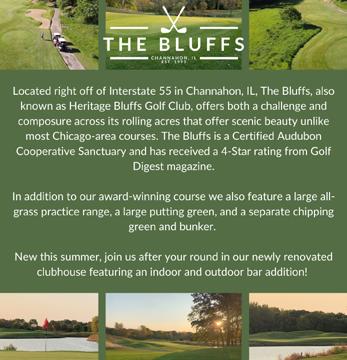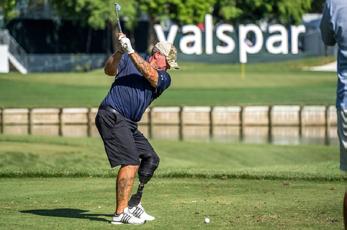
10 minute read
Helping Our Nation’s Heroes
Dave Silbar
Most of us don’t plan on life with physical and mental challenges galore. John Goudie, on the other hand, falls squarely into the “rough going” bucket. In 2012, the now-45-year-old Champaign native’s well-being dramatically changed.
Advertisement
While serving in the army in Afghanistan, Goudie was the victim of five gunshots through the chest and shoulder. The pain was excruciating. His left leg was lost and lifting his right arm was impossible. Trips to the operating room replaced his fighting for freedom on the front lines.
But the special forces were undeniably his calling and, after retiring, Goudie unbelievably returned to the rigors and risks of army life. After all, protecting national interests through combat was in his blood after his father and grandfather served in the armed forces for decades. Notwithstanding, Goudie’s debilitations were too much to manage and, in 2016, after earning bronze stars, his active military status came to an end for good.
As one might expect, not every Service member seamlessly transitions back into society. Joining your brothers and sisters at arms is the daily way of life and the civilian world is largely foreign.
Goudie lumbered through more than 50 surgeries in an attempt to repair this, that and almost every other part of his fragile body. Moreover, he suffered major PTSD that led to partying and drinking. Anger management wasn’t in his skill set.
“A war-torn country thousands of miles from Wrigley Field was all I knew for a long time,” Goudie says. “My focus on the strategic, military task at hand was No. 1; otherwise, one slight, ill-advised move could spell the end of you and your comrades.”
Upon experiencing wear-and-tear to the deleterious extreme, how’s a guy like Goudie going to change his path even remotely from near destruction to a high-functioning human being?
The answer: the game we all love. Golf.
On a whim of sorts, Goudie heard of the nonprofit On Course Foundation and a seven-day event the organization was conducting in Orlando. But he had never picked up a club and barely knew the difference between Tiger Woods and Tony the Tiger.
But for some inexplicable reason, a little birdie (no pun intended) in his mind— during a sober moment--told him to give it a try.
Goudie was smitten, so much so that he practiced religiously on the course and couldn’t get enough information about the golf world and business to satisfy an insatiable curiosity.
He even attended the Golf Academy of America to obtain an associate’s degree in business management. “On Course Foundation and golf gave me a career path I thought would never be possible,” he says with all smiles and the welling of tears in the eyes. “The effects of all things related to pushing a little white ball into a little white hole are amazing.”
For Goudie, concentrating on golf and productive activities replaced problems and a massive downward spiral. The turnaround was miraculous for self-esteem, and would lead to healthy relationships with his wife, kids, and other family members, a “dream profession in golf,” and financial stability.
Anger was replaced by purpose, one that was initially arduous to find post-Afghanistan.
On Course Foundation placed Goudie with Edwin Watts as a club fitter. During time away from work, his playing adeptness skyrocketed. Following more than 50 surgeries, powering off only one leg and an incapacitated right arm, work ethic and sheer dedication earned him a 4.5 handicap in his first five years on the links. If that’s not amazing, what is?
“When you love what you’re doing, be it professionally or on the course, it isn’t work,” he says.
Goudie is now National Programs Director of On Course Foundation, helping injured vets get in a better educational and physical headspace, just like the organization helped him.
“The vision is to provide a blend of tranquility on the golf course and skills for enjoyable and productive careers in golf to as many injured veterans as On Course Foundation can reach,” Goudie says. “I’m the poster child as it’s exactly what I needed after the intensity of front-line combat. I now enjoy mental acuity and a sustainable business life in golf, and I’m in better physical shape from swinging clubs and walking fairways.”
Happily married with three children and living in Destin, Florida, Goudie is hardly the only life On Course Foundation has saved. In its 14th year, the organization has diligently built an infrastructure that’s second to none. That purposeful, unwavering, professional strategy has helped it save scores of lives which otherwise could’ve headed toward tragic endings.
In its most remedial sense, On Course Foundation benefits wounded veterans who use golf as a vehicle for physical and mental recovery, and harvest newfound confidence into careers in golf. It conducts programs in 15 markets across America which help active and retired, injured Service members develop golf business and playing skills.
“Golf is a powerful recovery tool,” says John Simpson, Founder of On Course Foundation. “It’s a sport and business that helps injured vets, be they active or retired, balance their adrenaline-leaden lives with the need of calmer existences, sheer focus, and business and social goals.”
Simpson himself knows what overcoming odds is all about. Stricken with polio at a young age, he overcame adversity. The kindness of others helped him discover golf as an equalizer and specialization. Simpson went on to a formidable, decades-long career with International Management Group as agent for Nick Faldo and winners of 17 major golf tournaments.
Giving back is Simpson’s mantra, and his On Course Foundation succeeds aglow. It wouldn’t be right not to end this account without a salute to all involved with one of golf’s most heroic and important organizations.
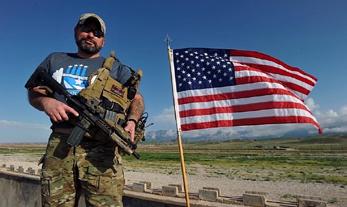



LIKE A LOCAL
Lush fairways, immaculate greens and challenging approach shots make Greater Lansing a truly memorable Midwestern golf destination. Book your getaway today! Love Lansing like a local and we promise, you’ll love Lansing as much as we do!
www.LANSING.org #LOVELANSING
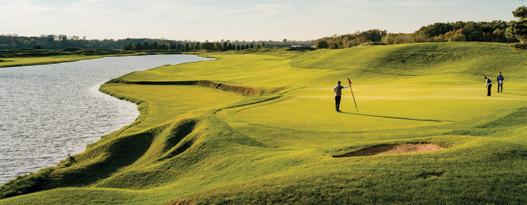
Mike Carbray
Game-like Practice
We all remember the Alan Iverson rant about “Practice – not a game – Practice.” If you want to shoot lower scores you need to listen to Alan and make your practice more like the game. A game has a score, a game has a winner. The best golfers all quantify their practice sessions and keep stats in their practice that they can then also track when they play.
Block Practice
There are two main forms of practice, Block and Random. Block would be best for learning a new skill or technique. Hitting a bag of balls to the same target from the same spot thinking about the swing changes you are making would be block practice. This is how you should practice if you just took a lesson and want to implement the skills you learned from your coach.
Last week I traveled to my local public course to practice short game with my son. The driving range was filled with people slashing away at buckets of balls. The chipping green was quiet, just one older man hitting a shag bag of balls to one flag. When he was done, he picked up the balls and then went to the same spot and dumped out the balls and hit to the flag again. This form of practice does not transfer to the actual playing situations as well as random practice. Does this sound like your practice? Whether you are the person on the range that walked by the short game area on the way or the one hitting his shag bag over and over. You will get better faster and would not have to practice as much if you randomized your practice when working on your game.
Random Practice
This forces the golfer to be more actively and cognitively engaged in the task. In random practice you build more lasting memories of the different shots and will also lead to less confusion on the course of play. Random practice means not hitting the same shot twice in a row, hitting to different holes from different positions and potentially with different clubs. Even if the results are not as good as the block version of practice, you will get better faster with the random form. Attention should be paid to each shot; you should treat it just like you would a shot in a round of golf. Look at where you want to land the ball, take a practice swing to replicate the shot you want to hit, then hit the shot. Take a second to watch the ball land and roll out. You want your brain to commit this to memory. If the shot was unsuccessful. Take a postshot practice swing for improvement, and then move on to a different shot. Every shot in practice should have an intention.
Make It A Game
Confidence comes from knowing that you are improving. One way to do this is to measure and test your practice sessions. Do a drill that has a score that you can track. I have hundreds of different drills that I ask my students to do. They keep their results in their phone or post them to a private social media platform that I can see. This helps me to know they are practicing, and I can see what they are doing on their own.
One easy drill to start with is a 10-ball chipping or pitching drill. Here is how it works: spread 10 balls out in an area randomly; I like to put some in the rough and some in the fairway. Then hit each ball to one of two different flags on the green. You can’t hit to the same flag twice in a row. When all 10 balls are hit, go up and putt them all out. You will then have a score of all the shots taken. For my high handicappers, we start with a score of 30 being the goal. That means one chip and two putts for all 10 balls. If they beat 30, the next goal is whatever they scored. Say they did the drill in 28 shots; then the next time they have to better 28 and set a new personal best.
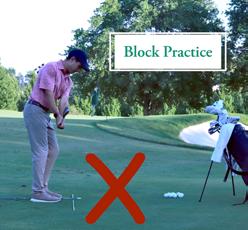
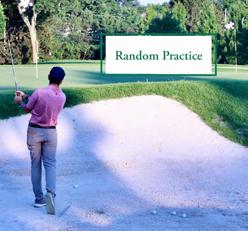
You cannot leave until you beat your previous score. This helps to add an element of stress to the practice, which is often hard to produce but shows up all the time on the course. If you have two balls left to putt to break your score and you need to make two to four footers to do so, you will feel a little stress. When you are playing a match with your friends and have a putt to win the hole, you can recall the practice and have more confidence on the course. With my lower handicappers the target score will be 25; make 5 up and downs and 5 in 3 shots.
The more you practice this form, the better you will get. It doesn’t just apply to chipping – you can do games with the driver and irons as well. I encourage you to make up your own games and ways to practice where you can quantify what you are doing. Keep a journal of your different drills and scores. When you play golf and struggle in one area of your game, make a game to work on that. If you come to the range with a thought-out practice schedule, your game will improve faster!

Mike Carbray is PGA Director of Instruction at Butterfield Country Club and the 2018 Illinois PGA Teacher of the Year. Instagram: @mikecarbraygolf Photos: Andrew Maslar Where one great course leads to another
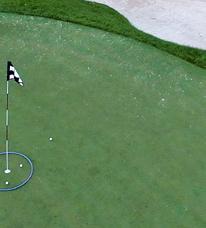
Discover 12 incredible courses at one unforgettable destination. Come PLAY and STAY with us. Book your Golf Trail Getaway today. Visit GolfAtLakeOfTheOzarks.com.
